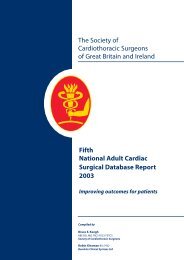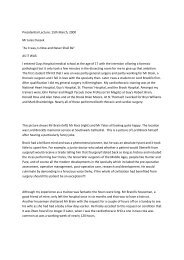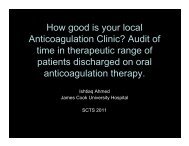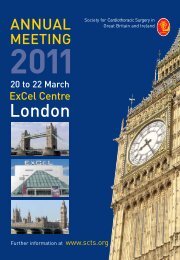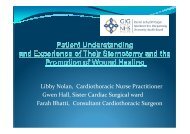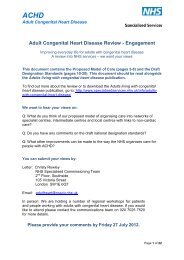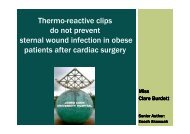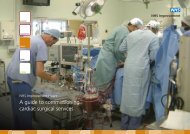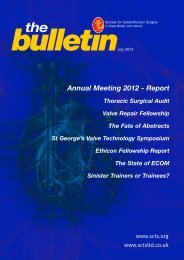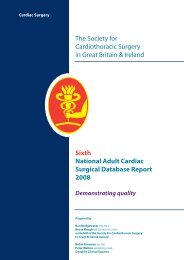Download - Society for Cardiothoracic Surgery
Download - Society for Cardiothoracic Surgery
Download - Society for Cardiothoracic Surgery
Create successful ePaper yourself
Turn your PDF publications into a flip-book with our unique Google optimized e-Paper software.
32<br />
theBulletin<br />
Sub-specialisation<br />
of thoracic aortic surgery within centres in<br />
the United Kingdom<br />
Thoracic aortic surgery in the UK, both<br />
elective and emergency work, has<br />
traditionally been low volume and<br />
per<strong>for</strong>med by most surgeons in most<br />
centres on an ad hoc occasional basis.<br />
While our national results <strong>for</strong> elective root<br />
surgery are comparable with international<br />
outcomes, UK results <strong>for</strong> surgery on the<br />
descending thoracic aorta,<br />
thoracoabdominal aorta and Type A aortic<br />
dissection have been less than ideal (SCTS<br />
bluebook 2003 and 2009). Evidence is<br />
accumulating that specialisation in aortic<br />
surgery improves outcome, particularly<br />
subspecialisation of centres rather than<br />
necessarily surgeons, suggesting it is the<br />
“system” which improves results. With<br />
vascular surgeons and interventional<br />
radiologist offering endovascular and<br />
hybrid solutions <strong>for</strong> complex thoracic<br />
aortic disease, it is incumbent on us to<br />
improve and publish outcomes <strong>for</strong> open<br />
surgery as well as involve ourselves in<br />
endovascular work. Indeed it is important<br />
<strong>for</strong> us as a specialty to defend this area of<br />
our practice. We have been given the<br />
ammunition to claim and defend this area<br />
by the National Institute <strong>for</strong> Clinical<br />
Excellence (NICE). In guidance on treating<br />
TAAA with stents they have stipulated that<br />
all patients with thoracic aortic aneurysmal<br />
disease should be discussed at a<br />
specialised multidisciplinary team<br />
meeting. By having a mandatory cardiac<br />
surgeon present in discussions with<br />
vascular surgeons and interventional<br />
radiologists objectivity should be ensured.<br />
The same guidelines suggest that all<br />
TEVAR should be per<strong>for</strong>med in centres with<br />
facilities <strong>for</strong> conversion and<br />
cardiopulmonary bypass if required. We<br />
believe these are the tools which Professor<br />
David Taggart has long campaigned <strong>for</strong> in<br />
defending coronary surgery. The process of<br />
dividing up centres and regions to do this<br />
work is complex and was the subject of a<br />
session at the Liverpool SCTS Meeting<br />
2010. Liverpool has started the process of<br />
subspecialising this service at a<br />
Consultant level and the process is<br />
described in this article in the spirit of<br />
sharing experience.<br />
Current national outcomes in the<br />
UK<br />
In<strong>for</strong>mation from Sixth Blue book (SCTS<br />
2008) suggests the UK has an elective<br />
mortality <strong>for</strong> root replacement of 8% while<br />
root repair with valve preservation is<br />
around 1%. Overall mortality <strong>for</strong> acute Type<br />
A dissection repair is 22.8%. Unlike the<br />
Blue book from 2003, the most recent<br />
update groups all “interposition tube<br />
grafts” together making it difficult to<br />
separate intervention on the ascending<br />
and descending aorta. However the 2003<br />
Blue book suggest open intervention on<br />
the descending thoracic aorta has a<br />
mortality of 9.1% (total cases 66) excluding<br />
trauma and on the thoracoabdominal aorta<br />
of 29.2% (total cases 24). Intervention in<br />
the United Kingdom as a whole is difficult<br />
to determine with the Vascular <strong>Society</strong>,<br />
British <strong>Society</strong> of Interventional<br />
Radiologists and commercial companies<br />
holding their own registries. What is<br />
certain is that we are in a battle to defend<br />
open intervention on the thoracic aorta<br />
and as specialty with the most history in<br />
this area, we should insist on the MDT<br />
process and position ourselves at the<br />
centre of that process, moderating<br />
intervention whatever it might be: open,<br />
endovascular or hybrid options.<br />
The Liverpool Thoracic Aortic<br />
Aneurysm Service<br />
Aortic surgery has been sub-specialised in<br />
Liverpool since May 2007. Currently there<br />
are three cardiac surgeons, two of which<br />
were employed specifically to lead in aortic<br />
surgery, who do almost all elective and oncall<br />
aortic activity. The appointments are<br />
an indication of the committement of the<br />
Trust to support this service both in<br />
facilities and in financially underwriting<br />
what is an expensive subspecialty. The<br />
Trust Board see this work as important<br />
service development increasing the<br />
national and international profile of the<br />
hospital.<br />
The UK TAVI Registry<br />
This <strong>for</strong>ms part of a more general UK TAVI evaluation<br />
programme, under the auspices of the UK TAVI Steering<br />
Committee (see below). This has been a collaborative process<br />
between the SCTS and BCIS in conjunction with; the Heart Team<br />
from the DoH, NICE, the MHRA and the Specialist<br />
Commissioners.<br />
This programme consists of 3 main strands; Risk Model<br />
Generation, the UK TAVI Registry and proposals <strong>for</strong> a UK RCT. The<br />
risk modeling group consisting Prof Nick Freemantle and his team<br />
,Dominic Pagano and Ben Bridgewater has completed<br />
sophisticated statistical modelling based on data from over<br />
50,000 valve operations. The model has been validated against<br />
the 08/09 dataset. The model will also be applied to the UK TAVI<br />
Registry database in due course.<br />
A detailed proposal <strong>for</strong> a RCT (UK-TAVI) has been submitted to the<br />
final stage of the HTA process. Briefly, this described a RCT of AVR<br />
vs TAVI. This is a pragmatic trial of any technology and any access<br />
with open inclusion criteria - recruitment based on the concept of<br />
an MDT deciding that either technique would be appropriate in<br />
any individual patient. This trial is a completely different trial to



